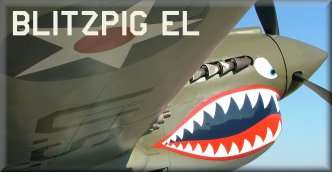
 |
|
|||||||
| IL-2 Sturmovik The famous combat flight simulator. |
 |
|
|
Thread Tools | Display Modes |
|
#11
|
|||
|
|||
|
In my opinion, USN fighters were quite unimpressive (or outright bad in some cases) compared to japanese planes. The very professional training and tactics that helped the US to win the war against japan. Ingame, online this is not the case, so the Zero, Hayabusa, Hien and especially the Hayate and the Raiden are more than a match for Wildcats or Hellcats. The only tactics that work against them is hit & run.
Offline, I think its a bit easier, because it seems that IJN/IJA AI is stupid. While USN AI is trying to cooperate to a degree, they dont. |
|
#12
|
|||
|
|||
|
Quote:
IMHO the supposedly pleasant attitude of the F6F does not translate in this game. And the F4U has great high speed roll rate. Quote:
Quote:
I don't know if IJN/IJA AI really is worse than USN AI. I sometimes get the impression that Ace level IJN pilots do at least some sort of coordinated attack - and average USN/USAAF AI does not work |
|
#13
|
|||
|
|||
|
Even in game the carrier based USN fighters are better than carrier based IJN fighters in all around performance. Of course, they don't turn on a dime.
|
|
#14
|
||||
|
||||
|
Up until late 42/early 43 the Japanese were the best trained combat pilots in the world, hands down, especially the IJN. They washed out pilots to crew positions that would have been aces in any other air force in the world.
This coupled with the poor tactical doctrine that the Allies started the war with (the dogfight), created the perfect storm for them in the first year or so of the war. This insane training regime also was the downfall of the Japanese air arm. They simply could not keep up with losses as the Allies adapted their tactics, and aircraft, to thawrt the Japanese.
__________________
 Personally speaking, the P-40 could contend on an equal footing with all the types of Messerschmitts, almost to the end of 1943. ~Nikolay Gerasimovitch Golodnikov |
|
#15
|
|||
|
|||
|
Quote:
The F4U and F6F are a bit different. The F6F Hellcat should be a bit more pleasant to fly than it is, but despite that it's definitely the easier of the two. Both are big heavy fighters (a F6F is larger than a P-47... think about that for a moment) with a lot of weight to carry around but they also have very powerful engines. The F4U Corsair is a bit trickier to handle. It's roll rate, top speed, and climb rate are all very good... but it's also less predictable. It's a little bit harder to land on a carrier deck which is one of the reasons why it earned the nickname 'Ensign Eliminator". In a late war fight the Corsair is probably the better option but against Zeros (common right to the last day of the war) but the Hellcat is also a great fighter. The USN tended to favour the Hellcat on carriers as it was easier to land and so it saw the majority of carrier use while the Corsairs were really only seriously active on carriers in later 1944 and 1945. The USMC made extensive use of the Corsair from land bases with very exceptional results - again... excellent training and the eventual accumulation of combat experience helped.
__________________
Find my missions and much more at Mission4Today.com |
|
#16
|
|||
|
|||
|
Quote:
 USN & USMC pilots facing Zeros for the second time usually came away with about equal results, and by the end of the Guadalcanal campaign, flying Wildcats, were well ahead in terms of victories to losses. Like the Finns, they had a very high standard of gunnery, and men who were acknowledged the best shots in the pre-war competitions were very successful when they got their chances (hint: Thach, O'Hare, and a guy named McCampbell were considered among the best marksmen in the USN-what a coincidence!). They were a tight-knit community who eagerly traded tips and tactics whenever they met, so Thach's weave and a clearer picture of Japanese capabilities and tendencies got around quickly in 1942. We tend to forget that the prewar US military could only afford to train and keep the very best, out of a much larger population pool than was available to Japan; the RAF and RCAF were the happy recipients of the services of a great many American aces and leaders who washed out of or were refused even the chance to get into USAAF and USN training. The Japanese, flying aircraft superior in every respect excepting dive acceleration and pilot protection, in many cases having years of combat experience, and all quite well-informed of their opponents' aircraft performances vs their own mounts, did not adjust well to changing circumstances and tactical innovations by their opponents and paid the price. Their training had also made them slaves to doctrine. That doesn't square with my understanding of 'best' training. cheers horseback |
|
#17
|
|||
|
|||
|
Quote:

|
|
#18
|
|||
|
|||
|
Well, every once in a while, even a blind squirrel finds an acorn. If you can cite one performance/tactical advantage that the F4F or even the F2A held over the A6M series besides the ones I mentioned, you win a prize.
cheers horseback |
|
#19
|
|||
|
|||
|
High speed maneuverability.
What did I win? Can I win more if I name another half dozen? |
|
#20
|
|||
|
|||
|
Quote:
Judges' decisions on any further entries are final. cheers horseback |
 |
| Thread Tools | |
| Display Modes | |
|
|